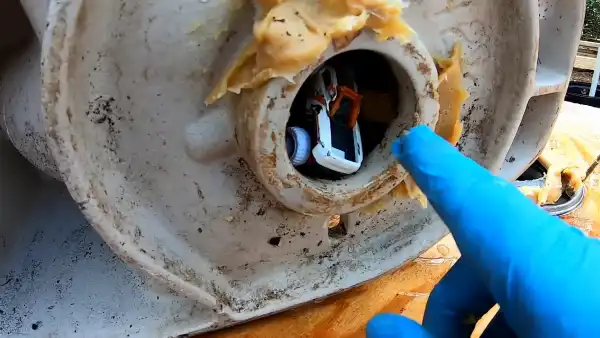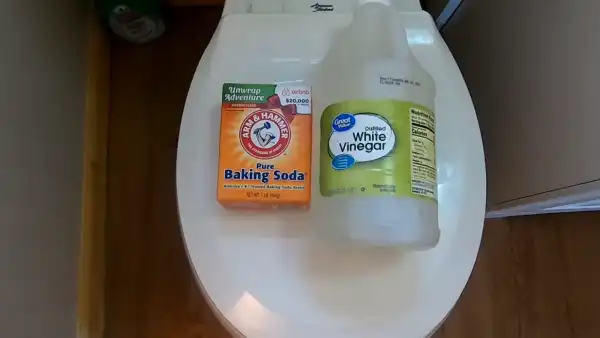Last Updated on October 17, 2023
Sometimes, a plastic item can accidentally fall into your toilet and get stuck. This can be an inconvenient situation, but there are solutions to dissolve the plastic and save you from a costly plumbing bill.
You can use Liquid Sosa (Liquid Lye), hot water and dish soap, and vinegar and baking soda to dissolve plastic stuck in the toilet. Each method has its advantages, and choosing the right one depends on the severity of the plastic’s stuckness and how much time you are willing to spend.
We’ll demonstrate 3 methods of dissolving plastic stuck in the toilet step-by-step so you can handle this issue safely and efficiently.
How to Dissolve Plastic Stuck in Toilet: 3 Methods with Step-by-Step

Several effective methods exist for dissolving plastic stuck in your toilet if you have ever encountered this problem.
1. Method 1: Liquid Sosa
- Step 1: Gather your materials
- Step 2: Prepare the toilet
- Step 3: Apply liquid lye
- Step 4: Wait for 30 minutes
- Step 5: Add more liquid lye
- Step 6: Overnight soak
2. Method 2: Hot water and dish soap
- Step 1: Add dish soap
- Step 2: Pour hot water
3. Method 3: Vinegar and baking soda
- Step 1: Add baking soda
- Step 2: Pour vinegar
Method 1: Liquid Sosa
Using Liquid Sosa (Liquid Lye) is a great way to dissolve plastic stuck in your toilet effectively. Below are the steps to follow for this method:
Step 1: Gather Your Materials
You will need the following materials to dissolve the plastic stuck in the toilet: Liquid Sosa (Liquid Lye), safety gloves, eye protection, and a container for mixing the solution.
To protect yourself from any potential harm, wear safety gloves and eye protection. The Liquid Sosa will act as a powerful solvent that can break down the plastic.
Step 2: Prepare the Toilet
Once you’ve gathered the necessary materials, ensure there’s no water in the toilet bowl. You can either use a wet-dry vacuum or manually scoop out the water. Using a wet-dry vacuum is efficient and simple.
Connect the hose to the appropriate setting, place the nozzle in the water, and start the machine. It will quickly suction out the water.
Alternatively, you can manually scoop the water using a container or bucket. Dip it into the water and pour it into a suitable receptacle until the bowl is completely empty.
Step 3: Apply Liquid Lye
After emptying the toilet bowl, it is time to apply liquid lye to the toilet bowl. Pour 150 ml of liquid lye directly into the toilet bowl. The liquid lye will begin its work on the plastic obstruction, breaking it down over time.
Step 4: Wait for 30 Minutes
Now that you’ve applied the liquid lye to the plastic stuck in your toilet, it’s time to let it do its job. Wait patiently for approximately 30 minutes, allowing the lye to work its magic and break down the plastic.
During this time, chemical reactions will loosen the plastic and make it easier to remove. Be sure to exercise caution and avoid any contact with the lye during this waiting period.
Step 5: Add More Liquid Lye
To continue the process, pour an additional 250 ml of liquid lye into the bowl. The extra lye will further break down and soften the plastic, making it easier to remove.
Ensure that you pour the liquid evenly around the affected area for maximum effectiveness.
Step 6: Overnight Soak
For best results, let the liquid lye sit in the toilet bowl overnight to allow it enough time to break down and soften any stubborn debris effectively.
During this 7 to 9-hour period, avoid flushing the toilet to ensure the liquid lye can work its magic. After the overnight soak, you can safely flush away the dissolved plastic and debris.
Method 2: Hot Water and Dish Soap
Another effective method for dealing with plastic stuck in your toilet is using hot water and dish soap. Follow these steps:
Step 1: Add Dish Soap
To start, ensure that the toilet bowl is empty of water. Then, squirt a generous amount of dish soap down the toilet bowl to make the surface slippery.
Step 2: Pour Hot Water
When you’re done adding dish soap, carefully pour about 2 liters of very hot water into the toilet. The heat from the water will cause the plastic to become more pliable, allowing it to break apart or dissolve completely. Let it sit for approximately 10 to 15 minutes, and then flush it.
Method 3: Vinegar and Baking Soda

Vinegar and baking soda present an eco-friendly and accessible solution for resolving plastic obstructions in your toilet. Here’s how:
Step 1: Add Baking Soda
Empty the toilet bowl of water. Then, pour approximately one cup of baking soda into the empty toilet bowl. Make sure to distribute the baking soda evenly around the bowl.
Step 2: Pour Vinegar
Now, you’ll need to pour about 2 to 3 cups of vinegar into the bowl. The acidity of the vinegar will aid in breaking down the plastic stuck in the toilet.
Make sure to distribute the vinegar evenly throughout the affected area. Let the mixture sit for about 30 minutes in the toilet bowl to get the best results.
If the plastic doesn’t dissolve completely after the first attempt, you can repeat the process until the plastic is adequately softened and removable.
Once you’re satisfied that the plastic has sufficiently dissolved or softened, you can proceed to flush the toilet.
Can you use acetone to dissolve plastic stuck in a toilet?
Using acetone solvent to dissolve plastic stuck in your toilet can be effective initially, but be aware of the potential damage it may cause to your plumbing system.
While acetone is known for dissolving plastic, it can also negatively affect PVC drain piping commonly used in plumbing systems. The interaction between acetone and PVC pipes can weaken and even break the pipes over time.
Triumph Over Toilet Troubles: Conquer Clogs with Confidence
The plastic stuck in your toilet is no longer a problem with these easy fixes. Patience is the key to choosing Liquid Sosa, Hot Water, Dish Soap, or Vinegar and Baking Soda. Allow sufficient time for the solutions to work their magic, allowing the plastic to soften or dissolve.
If you’re satisfied that the plastic obstruction has been adequately addressed after following the steps, you can confidently proceed to flush the toilet.
These DIY methods offer practical and eco-friendly solutions to save you from the inconvenience of a clogged toilet and potentially costly plumbing bills.
